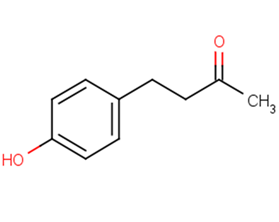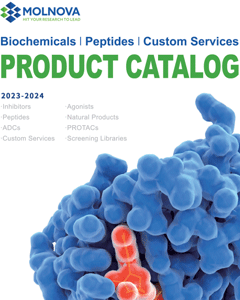
Raspberry ketone
CAS No. 5471-51-2
Raspberry ketone( Frambione | 4-(4-Hydroxyphenyl)-2-butanone )
Catalog No. M18780 CAS No. 5471-51-2
4-(4-Hydroxyphenyl)-2-butanone(RK) is cytotoxic to melanocytes through the binding of RK-derived quinones to thiol proteins and the pro-oxidant activity of the RK-oligomer.
Purity : >98% (HPLC)
 COA
COA
 Datasheet
Datasheet
 HNMR
HNMR
 HPLC
HPLC
 MSDS
MSDS
 Handing Instructions
Handing Instructions
| Size | Price / USD | Stock | Quantity |
| 100MG | 37 | In Stock |


|
| 200MG | Get Quote | In Stock |


|
| 500MG | Get Quote | In Stock |


|
| 1G | Get Quote | In Stock |


|
Biological Information
-
Product NameRaspberry ketone
-
NoteResearch use only, not for human use.
-
Brief Description4-(4-Hydroxyphenyl)-2-butanone(RK) is cytotoxic to melanocytes through the binding of RK-derived quinones to thiol proteins and the pro-oxidant activity of the RK-oligomer.
-
Description4-(4-Hydroxyphenyl)-2-butanone(RK) is cytotoxic to melanocytes through the binding of RK-derived quinones to thiol proteins and the pro-oxidant activity of the RK-oligomer, the exposure of human skin to RK can cause chemical/occupational leukoderma. 4-(4-Hydroxyphenyl)-2-butanone is marketed on the Internet as a food supplement.
-
In VitroRaspberry ketone (1, 10, 20, and 50?μM) suppresses adipogenesis and lipid accumulation in 3T3-L1 pre-adipocytes. Raspberry ketone (10?μM) significantly blocks C/EBPα, PPARγ, and aP2 expression and increases the expression of ATGL and HSL, and CPT1B.
-
In VivoRaspberry ketone (0.5%, 1%, or 2%) increasses the levels of total cholesterol (TC), triglycerides (TG), low-density lipoprotein cholesterol contents (LDL-C), ISI (insulin-sensitivr index), PPAR-α and LDLR, decreases the serum levels of AST (aspartate aminotransferase), ALT (alanine aminotransferase), ALP (alkaline phosphatase), IRI (insulin resistance index), GLU (glucose), INS (insulin-sensitivr index), LEP (leptin), and TNF-α in rats compared with a high-fat diet-induced NASH model. Raspberry ketone also causes increased SOD activities. Raspberry ketone shows cardioprotective action against isoproterenol-induced myocardial infarction in rats, and the effects may be due to its PPAR-α agonistic activity.
-
SynonymsFrambione | 4-(4-Hydroxyphenyl)-2-butanone
-
PathwayCytoskeleton/Cell Adhesion Molecules
-
TargetMicrotubule/Tubulin
-
RecptorOthers
-
Research AreaOthers-Field
-
Indication——
Chemical Information
-
CAS Number5471-51-2
-
Formula Weight164.2
-
Molecular FormulaC10H12O2
-
Purity>98% (HPLC)
-
SolubilityIn Vitro:?DMSO : 100 mg/mL (609.01 mM)
-
SMILESCC(=O)CCC1=CC=C(C=C1)O
-
Chemical Name——
Shipping & Storage Information
-
Storage(-20℃)
-
ShippingWith Ice Pack
-
Stability≥ 2 years
Reference
molnova catalog



related products
-
Deoxypodophyllotoxin
Deoxypodophyllotoxin shows cytotoxic , antineoplastic, antitumor, insecticidal, anti-angiogenic, vascular disrupting, insecticidal, antiviral, and anti-inflammatory activities.Deoxypodophyllotoxin (DPT) induced both apoptosis and autophagy via production of mitochondrial reactive oxygen species (ROS).?
-
McMMAF
McMMAF is a protective group-conjugated MMAF. MMAF is a potent tubulin polymerization inhibitor.
-
Sodium?Dichloroaceta...
Dichloroacetate ion inhibits pyruvate dehydrogenase kinase, resulting in the inhibition of glycolysis and a decrease in lactate production.



 Cart
Cart
 sales@molnova.com
sales@molnova.com


